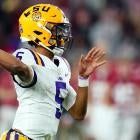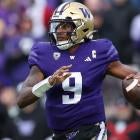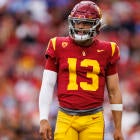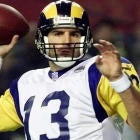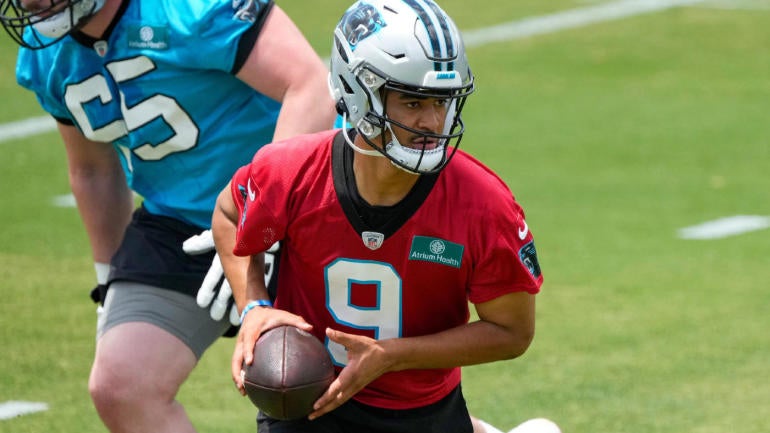
What's the worst that could happen? A fair question to ask when a rookie quarterback is thrust onto an NFL field in his rookie season, especially if most believe he's playing too soon.
But NFL coaches are people just like the rest of us, and society today isn't too fond of waiting to get their young quarterbacks into a regular-season game. And as we've seen with the likes of Justin Herbert and Joe Burrow, sometimes rookie passers can experience a best-case scenario in Year 1.
In this article, I've gone deep and gotten very specific in my determination of the best- and worst-case scenarios for the 2023 rookie quarterbacks, just like I did last year for Kenny Pickett, Desmond Ridder and Co. As you'll see below, the figures are based upon these quarterbacks actually getting a chance to play considerable snaps in their first seasons -- which of course isn't a guarantee for all those passers drafted.
But for the sake of argument, we're going to assume the quarterbacks included all get a sizable opportunity. And top 5 picks Bryce Young, C.J. Stroud and Anthony Richardson should. From there, I took liberties with how much above or below the averages I feel each quarterback could land in a best- and worst-case scenario.
To begin, I found parameters of expectations for these first-year passers. As a baseline, I used the seasons from the 19 quarterbacks threw at least 200 passes as a rookie over the past five seasons. Here's a look:
| Completion | Yards Per Attempt | TD % | INT % | QB Rating | Sack % | |
|---|---|---|---|---|---|---|
High mark (Justin Herbert, 2020) | 66.6% | 7.3 | 5.2 | 1.7 | 98.3 | 5.10 |
Low mark (Josh Rosen, 2018) | 55.2% | 5.8 | 2.8 | 3.6 | 66.7 | 10.27 |
Average of entire group | 61.5% | 6.74 | 3.73 | 2.71 | 82.5 | 7.39 |
Now, in theory, using a larger sample size would be conducting this study by the book. However, NFL studies are not like most other studies in that a larger sample size can actually be counterproductive because of how swiftly the game changes for everyone on the field, most notably the quarterbacks. Including passers from even before, say, 2018 feels too outdated to be predictive whatsoever.
For context on the averages, the 61.5% completion was almost identical to what Marcus Mariota's was last year. The 6.74 yards-per-attempt figure was comparable to Dak Prescott and Derek Carr in 2022. The average TD% of 3.8 was right between Justin Herbert and Carson Wentz a season ago. The 2.71% interception rate was between Matt Ryan and Matthew Stafford. The collective's 82.5 rating would've been smack dab between Wentz and Ryan, and the 7.39% sack rate was comparable to Mac Jones and Lamar Jackson's rates from 2022.
Now that you have genuine, stat-based expectations to refer to, let's get to best- and worst-case scenarios for 2023 rookie passers.
Bryce Young
Best-case scenario: 67% completion, 7.3 yards per attempt, 3,650 passing yards, 25 TD passes, 9 INTs, 30 sacks, 97.5 rating
Worst-case scenario: 60% completion, 6.1 yards per attempt, 2,440 passing yards, 10 TD passes, 12 INTs, 32 sacks, 74.1 rating
The best-case and worst-case scenarios here are a bit abnormal. They're not based on the same amount of pass attempts. And of course I'm not one to confidently predict injuries of any kind, for any player, at any position, but given Young's size and tendency to create when pressure mounts, the worst-case scenario would factor in an injury that'd cause him to miss some time.
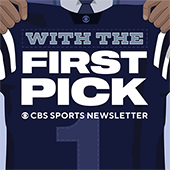
With The First Pick Newsletter
With The First Pick Newsletter
Prepare for the upcoming NFL Draft with the day’s big stories + mock drafts, big board updates and more.
Thanks for signing up!
Keep an eye on your inbox.
Sorry!
There was an error processing your subscription.
With Frank Reich, Jim Caldwell, and Josh McCown on the Panthers staff, it's safe to assume that trio will be able to provide Young many easy completions, the theme for Young's scheme, and the former Heisman winners has rapid processing and anticipatory passing skills, so setting a new high mark for completion rate shouldn't surprise anyone.
C.J. Stroud
Best-case scenario: 64% completion, 7.0 yards per attempt, 3,325 passing yards, 21 TD passes, 12 INTs, 33 sacks, 88.7 rating
Worst-case scenario: 57% completion, 6.3 yards per attempt, 2,993 passing yards, 15 TD passes, 17 INTs, 48 sacks, 71.5 rating
Given that Stroud landed with a defensive-minded head coach and has an offensive coordinator from the Kyle Shanahan coaching tree, there's a good chance Houston will want to emphasize the run game -- relatively speaking -- for their first-year quarterback. So Stroud's figures were based on a somewhat modest 475 attempts across 17 games.
Houston will be more competent in 2023 than the club has been over the past two rather dismal seasons. A litany of free-agent additions will be key in that improvement. But the receiver group still isn't super-threatening, and Brandin Cooks is now on the Cowboys. That all speaks to the worst-case scenario for Stroud.
Given his two years of high-level efficiency at Ohio State, it's certainly well within the realm of possibility that Stroud demonstrates plenty of veteran-like qualities as a pure pocket passer -- while sprinkling in the occasional scramble when needed. The run game will be vital for offensive coordinator Bobby Slowik; let's not forget the Shanahan scheme has a long history of getting awesome efficiency from its quarterback.
Anthony Richardson
Best-case scenario: 61% completion, 7.0 yards per attempt, 3,150 passing yards, 23 TD passes, 11 INTs, 25 sacks, 89 rating
Worst-case scenario: 55% completion, 6.4 yards per attempt. 2,280 passing yards, 14 TD passes, 14 INTs, 34 sacks, 67.2 rating
I know what you're thinking -- given Richardson's universally agreed-upon rawness, his worst-case scenario has to be worse than that, right? My counter -- remember who his head coach is. It's the same head coach who was part of Justin Herbert's record-setting rookie season in 2020 and played an integral role in the sensational schematic environment around Jalen Hurts in 2021 and, of course, his breakout in 2022.
I used Hurts' first two years with the Eagles -- one of which was with Shane Steichen -- as a general guideline, and of course, factored how well I believe Richardson can play, and how efficient he truly can be as a rookie with this Colts roster. In an essentially 'everything goes right' world for the Colts, Richardson takes what the defense gives him often under Steichen's watchful eye, does have some blatant misses, but keeps his yards-per-attempt average relatively high for a rookie with the occasional long-ball connection. Don't forgot, too -- much of what Richardson will do in his first NFL season will come on the ground with his otherworldly athleticism and size.
Will Levis
Best-case scenario: 63% completion, 6.6 yards per attempt, 2,310 passing yards, 16 TD passes, 7 INTs, 21 sacks, 89.1 rating
Worst-case scenario: 56% completion, 6.2 yards per attempt, 1,800 passing yards, 9 TD passes, 12 INTs, 27 sacks, 67.9 rating
For the best-case scenario I went 325 attempts for Levis, close to the same number of passes Ryan Tannehill threw last season in 12 contests. I think it's decently unlikely Levis unseats Tannehill immediately in 2023, and even if he plays sooner than mid-October, chances are the Titans are going to be extraordinarily Derrick Henry, Haason Haskins and Tyjae Spears heavy offensively.
Levis' worst-case scenario is low across the board, mostly due to the Titans arguably having the worst receiver group in football and an offensive line still in need of improvement, even with the addition of first-round pick Peter Skoronski. Not having dynamic pass-catching options -- and, yes, tight end Chig Okonkwo flashed as a rookie -- is the start of the recipe for disaster for a young quarterback. I used a 300-attempt sample in Levis' worst-case scenario, essentially hinting at lesser playing time than the 12-game sample for the better scenario.






















